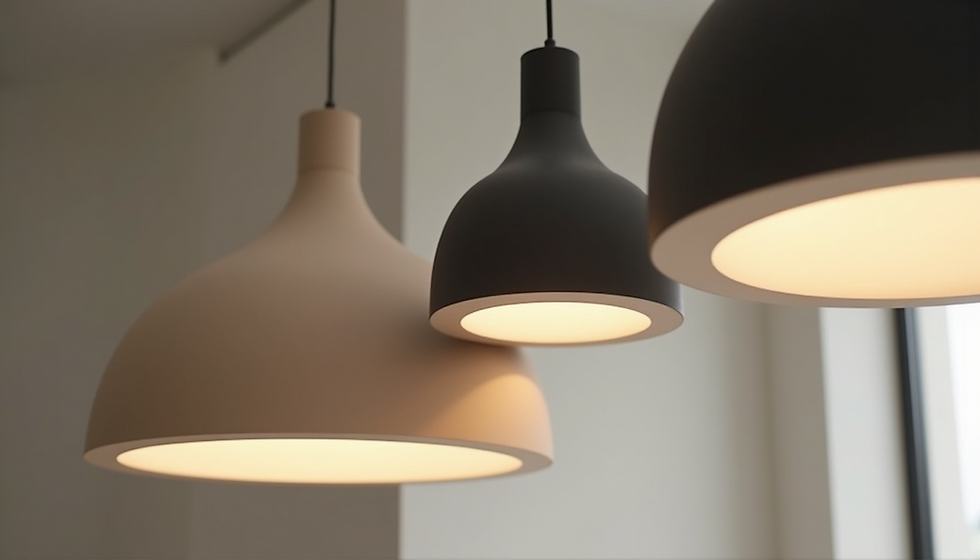Enhancing Interiors with Thoughtful Lighting Design
- MOSS Objects
- Jun 30
- 4 min read
Lighting is one of the most powerful tools in interior design. It can create ambiance, enhance colors, and influence mood. The right lighting design can transform an ordinary room into an extraordinary space. Whether you're revamping your home or designing a new space, understanding the impact of lighting is essential.
Understanding Interior Lighting
When selecting lighting for your home, it's crucial to understand the different types of lighting available. Generally, there are three categories: ambient, task, and accent lighting.
Ambient lighting offers a source of general illumination for a space. This can be overhead fixtures, chandeliers, or natural light from windows.
Task lighting illuminates specific areas for activities like reading, cooking, or work. Desk lamps, under-cabinet lighting, and bedside lamps fall into this category.
Accent lighting highlights features like artwork, architectural details, or decorative elements. Spotlights and wall sconces are commonly used for this purpose.
Understanding these categories will help you make informed decisions about which types of lighting to combine for the best effect.

Layering Your Lighting Design
One of the most effective techniques in lighting design is layering. Combining different types of lighting creates depth and dimension in your space.
Start with ambient lighting as your foundational layer. This is the overall light source that fills a room. Next, add task lighting where needed, focusing on areas where activities occur. Lastly, use accent lighting to draw attention to special features in the room.
For example, in a kitchen, pendant lights over the island serve as ambient light. Under-cabinet lights provide task lighting for meal preparation. Finally, a spotlight on a piece of artwork completes the look with accent lighting. This layered approach creates a well-rounded atmosphere.

Benefits of Thoughtful Lighting
Thoughtful lighting design does more than just enhance aesthetics. It can significantly affect the functionality and comfort of a space. Well-planned lighting can improve energy efficiency, safety, and the overall mood of the area.
Improved Energy Efficiency
Using energy-efficient bulbs and fixtures can reduce electricity bills. Modern LED bulbs consume less energy compared to traditional incandescent bulbs. Additionally, incorporating smart lighting can further enhance efficiency. Smart bulbs can be programmed to turn on and off according to your schedule, reducing wastage.
Enhanced Mood and Productivity
Lighting influences how we feel. Natural light is known to boost mood and productivity. Aim to maximize natural light during the day; it’s both energizing and uplifting. In the evenings, opt for warm light sources to create a cozy atmosphere. Research indicates that environments with appropriate lighting can lead to better concentration and overall productivity.
Increased Safety
Proper lighting contributes to safety. Ensure entrances, stairways, and hallways are well-lit to reduce the risk of accidents. Use motion sensor lights for outdoor areas and pathways. These lights automatically illuminate when someone approaches, enhancing safety while also providing convenience.
Choosing the Right Fixtures
Selecting the right lighting fixtures plays a critical role in your design. With thousands of options available, it can be overwhelming. Here are some tips to help you choose wisely:
Consider Scale
The size of your lighting fixtures should be proportionate to the space. An oversized chandelier in a small dining room can overwhelm the design. Conversely, tiny pendant lights in a spacious kitchen may look lost. Research standards for fixture sizes based on room dimensions to ensure proper scale.
Style Coordination
Your lighting fixtures should coordinate with your overall decor style. A minimalist room may benefit from sleek, modern fixtures. In contrast, a vintage-inspired space might shine with antique-style lighting. Pay attention to finishes as well. Mixing metals can add interest, but overly complex combinations can clash.
Functionality vs Aesthetics
While aesthetics are essential, don't overlook functionality. For instance, a beautiful lamp can serve as an accent piece, but only if it also provides sufficient light for reading. Test different fixtures in your space to evaluate both their visual appeal and effectiveness.

Embracing Smart Technology
Incorporating smart lighting technology into your home can enhance convenience and efficiency. Smart lights can be controlled via smartphone apps, allowing you to adjust brightness and color temperature on demand.
Convenience and Accessibility
Imagine entering your home and having the lights turn on automatically. Smart systems can be programmed to align with your lifestyle. For example, you could set the lights to dim in the evening and brighten in the morning. These systems often allow for voice control and can be integrated with home assistants, making them easy to use.
Energy Management
Smart lighting allows for real-time monitoring of your energy usage. Some systems will provide insights into your consumption, enabling you to make informed choices about your lighting habits. With features like remote access, you can turn off lights left on when you're not home. This can lead to substantial savings on your electric bill over time.
Final Thoughts on Thoughtful Lighting Design
Enhancing interiors with thoughtful lighting design involves careful planning and consideration. By understanding the types of lighting, employing a layered approach, and selecting the right fixtures, you can create spaces that are not only beautiful but also functional and inviting.
Incorporating modern solutions, such as smart technology, will elevate your design further. Remember, lighting is not an afterthought—it's a crucial element that plays a pivotal role in transforming any space.
For those interested in more refined options, exploring ideas in interior architectural lighting can provide inspiration that combines artistry with functionality. The right lighting can enhance your lifestyle and enrich your daily experiences at home.



The way lighting can completely shift a room’s atmosphere really stands out in your article. I’ve noticed that adding different lamps and lights creates not only warmth but also a layered look that makes any space feel more intentional and welcoming.